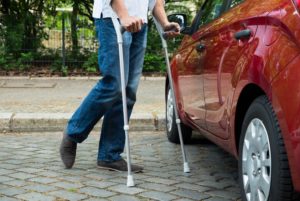Personal Injury Law: Defining Negligence
 If you have been harmed by someone else’s wrongdoing, you may be able to hold the at-fault party accountable in a court of law, thus enabling you to receive compensation for the injuries and lost wages you suffered as a result of the wrongdoing.
If you have been harmed by someone else’s wrongdoing, you may be able to hold the at-fault party accountable in a court of law, thus enabling you to receive compensation for the injuries and lost wages you suffered as a result of the wrongdoing.
The legal doctrine of tort law allows you to sue someone for negligence if you suffered personal injury as a result of his or her conduct. Here are the four steps to proving negligence in a personal injury case:
You Were Owed a Duty of Care
The first step to defining negligence is showing that the person who wronged you owed reasonable a duty of care now to harm you. This means the duty to not do something that a reasonably prudent person would not do. For example, a doctor owes a duty of care to his patient and can be held responsible for providing subpar care or for acting in a reckless or careless manner.
The Duty Was Breached
Once you show that the at-fault party had a duty to keep you safe, you must have proof that the duty was breached. In medical malpractice cases, for instance, this can be shown through evidence of surgical errors or other mix-ups.
You Were Actually Harmed
Next, your negligence claim rests on showing that not only was the duty breached, but that you suffered an injury as a result of that breach. If a driver runs a red light but does not cause an accident, then there was not actual harm. However, if that driver runs a red light and causes a large collision, you will easily be able to prove actual harm.
The Other Party’s Conduct Actually Caused Your Injuries
This step may seem repetitive, but proving negligence is largely about showing that your injuries were proximately caused by the other party’s actions.
This is simple in medical malpractice or car accidents, but harder in product liability or cases where a company’s actions caused downstream injuries. Fortunately, an experienced lawyer can help in any case of negligence.
How Negligence Factors Into Wrongful Death Cases
Wrongful death is a term used to describe an instance in which the death of a person was caused due to either the deliberate acts or negligence of another.
Negligence is defined as the actions of a person that fall below the standard of care that a reasonably prudent person in the same situation would show. In other words, negligence is carelessness, or the opposite of diligence.
When we put the two terms together, a wrongful death caused by negligence entails that someone was killed by the careless actions of another.
This is the most common type of wrongful death suit, and wrongful death claims based on negligence can be implicated in any field of work or walk of life.
It may be a fatal car accident in which the other driver was speeding or using a cell phone while driving, or it may be due to the negligence of a surgeon during an operation, leading to the death of the patient.
A wrongful death suit is comprised of the following elements:
- The death of a person occurred.
- Caused by another person’s negligence or deliberate act.
- Surviving family members are suffering injuries or damages as a result.
In regard to the second element of a wrongful suit, proving negligence requires a showing of several elements.
You must show that the other party:
- Had a duty of care to the victim.
- That the defendant breached that duty.
- That the breach was the cause (actually and proximately) of the injury or death.
- The damages suffered as a result.
The facts of the individual case make these elements easier or more difficult to show, so contacting an experienced personal injury attorney is the best way to evaluate your case and decide whether pursuing compensation is the best choice for you.
Call a Knowledgeable Wrongful Death Attorney
While negligence may be apparent from a practical view, in many instances, proving negligence in a legal setting is a different matter altogether.
Negligence in a wrongful death suit is an even more complex undertaking. You should always consult with an experienced wrongful death attorney when considering your options.
If you live in the Washington DC area and would like to consult with an attorney, contact the Rich Firm at 1-888- RICH-LAW (742-4529). Our experienced staff can answer any questions you may have. Call us today to learn how we can help put you on the path to receiving the just compensation you deserve.




